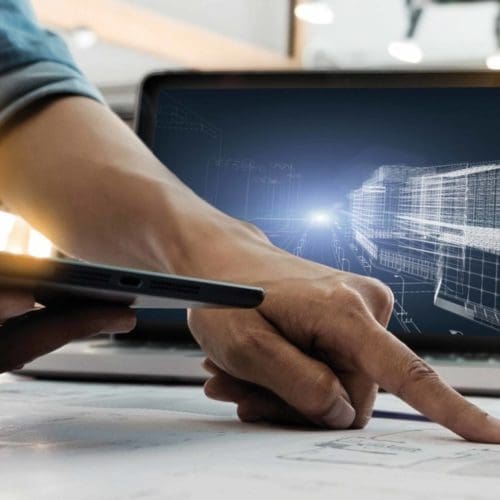The Impact of Innovative Technology in the Construction Industry: Staying Ahead of the Curve
September 2023The construction industry continues to undergo a digital transformation with the integration of innovative technology which is transforming the way construction projects are designed, executed, and managed. In this article Ian Masser and Sophie-Rose Bowen discuss some of the ways that innovative technology is being used in the construction industry and the potential legal issues which may arise.
Innovative technology has the potential to significantly increase efficiency, productivity, and safety on construction projects. Aids such as artificial intelligence (AI) and augmented reality (AR) are being used during the design process. Furthermore, hard hat sensors and driverless vehicles are starting to be used on construction sites. However, the rise of technologies brings unique challenges and risks to developers, consultants and contractors and it is important that they keep up to date with the potential risks posed by new technologies to minimise exposures to future claims.
Emerging Technologies: Some Industry Examples
Emerging technologies can serve numerous purposes in construction projects, from improving health and safety, increasing project sustainability, reducing the risk of design and workmanship defects, and improving project efficiency and economics.
Health and Safety
AI-integrated construction PPE methods such as exoskeletons, smart glasses, and smart boots intend to address health and safety on construction sites by minimising the weight of products to be lifted, monitoring a worker’s heart rate for signs of fatigue, alerting workers to potential hazards, and detecting harmful substances such as gas.
Furthermore, drones and other robotics technology are being used on construction projects to address health and safety issues. Amongst other things, drones can help with site surveillance, ensuring that workers do not need to enter potentially dangerous zones and can instead monitor construction from a distance.
Sustainable Construction
AI can assist with project sustainability and minimisation of environmental impacts.
- 3D printing allows designers such as engineers to create detailed CAD models of their proposed structures to be fed into a 3D printer, which then uses a variety of materials to create a physical version of the design. 3D printers use the exact amounts of materials needed for construction, so they typically generate almost zero waste. A further environmental benefit of 3D printing is that it can use recycled materials.
- Drones can also reduce the amount of vehicle usage at construction sites, saving time and reducing carbon emissions.
Construction Defects
AR can project 3D images onto a user’s physical surroundings as they walk around a construction site with the advanced sensory technology. It can be used by designers such as engineers to virtually remove and relocate structural components before applying changes to a building, which can help to reduce design issues. In addition, AR can assist with design coordination. It allows users to share notes or videos of potential design errors so that they can be communicated to the rest of the design and construction team.
Drones are also being used to monitor and survey construction in order to identify departures from design at an early stage.
Efficiency and Economics
It is also thought that innovative technologies can improve the efficiency of construction projects and reduce delays and costs overrun.
- 3D printing has the potential to reduce labour costs and time for construction projects;
- AR can also measure a building’s height, width and depth which can then be incorporated into models to allow construction companies to create accurate material and labour estimates and construction programmes; and
- Drones can also be used to help with the construction planning process. By using drones, workers can review the layout of a construction site accurately, preventing potential problems from happening later on in the project.
Emerging Technologies: Impact
By 2030, the design and construction of projects could look very different if the technologies discussed above become commonplace and/more technology innovations are introduced into the construction industry.
Innovative technology raises a number of potential legal issues that developers, contractors and consultants need to be mindful of.
- The implementation of innovative technologies could give rise to health and safety claims, for example, where a worker is injured after relying on a wearable device that failed to detect a hazard. In such circumstances, questions may arise as to whether the manufacturer of the wearable device could have some liability for a failure to detect, or alternatively, whether the employer could have liability;
- Construction wearables present legal issues related to data, privacy and cybersecurity. There may be consequences for failing to keep data from construction wearables secure. As such, the type and amount of data collected by wearables means companies that control said data may expose themselves to liability; and
- Technologies such as AR (which can rely on internet connectivity) may cause disruption to construction projects in the event of lost connectivity. This could result in substantial issues on the construction site and lead to long delays and rises in construction costs which form the basis for potential claims.
It is likely that dispute resolution procedures used in the construction industry such as litigation, arbitration and adjudication will need to adapt to address the rises in use of innovative technology.
A number of immediate questions present themselves to construction lawyers. For instance, to what extent would a construction wearable such as an exoskeleton or drone constitute a document that needs to be disclosed during the course of litigation in circumstances where the Court rules currently defines a document as “anything in which information of any description is recorded”? Where AI-related technologies are alleged to have caused and/or contributed to issues on construction projects, to what extent can parties call upon expert evidence and/or factual witness evidence to assist with determining causation?
Limiting Exposure(s)
There are various ways that developers, consultants and contractors can limit their exposures to potential claims relating to the use of innovative technology.
Clearly outlining obligations from the outset of a project through contractual appointments that suitably address the input and expectations of each party with respect to the technology to be used, ownership of the technology, as well as responsibility for any issues that could arise with the technology could minimise exposure to claims. Companies should ensure early engagement with their legal advisors to seek advice on how to minimise exposures to risks relating to the use of innovative technology on construction projects.
Furthermore, developers, contractors and consultants should ensure that their professional indemnity policies provide cover in relation to claims that may arise from the use of innovative technologies on construction projects. Again, early engagement with professional indemnity insurers and brokers will be important.
Download PDF








